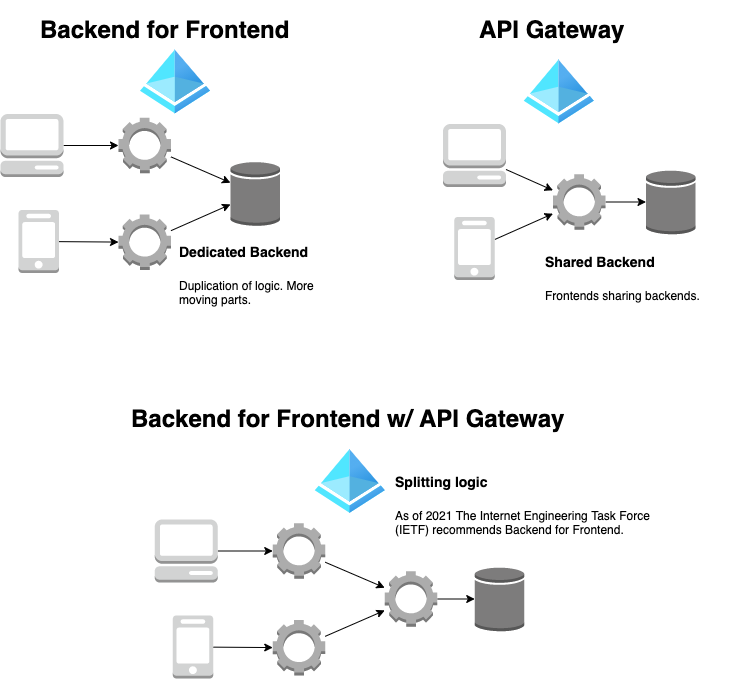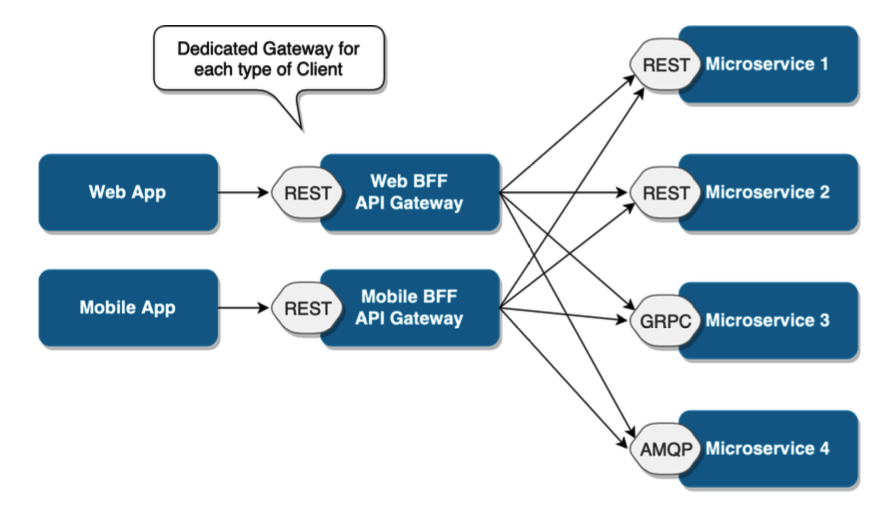Backend for Frontend
JavaScript Applications with a Backend
+-------------+ +--------------+ +---------------+
| | | | | |
|Authorization| | Token | | Resource |
| Endpoint | | Endpoint | | Server |
| | | | | |
+-------------+ +--------------+ +---------------+
^ ^ ^
| (D)| (G)|
| v v
|
| +--------------------------------+
| | |
| | Application |
(B)| | Server |
| | |
| +--------------------------------+
|
| ^ ^ + ^ +
| (A)| (C)| (E)| (F)| |(H)
v v + v + v
+-------------------------------------------------+
| |
| Browser |
| |
+-------------------------------------------------+
JavaScript Applications without a Backend
+---------------+ +--------------+
| | | |
| Authorization | | Resource |
| Server | | Server |
| | | |
+---------------+ +--------------+
^ ^ ^ +
| | | |
|(B) |(C) |(D) |(E)
| | | |
| | | |
+ v + v
+-----------------+ +-------------------------------+
| | (A) | |
| Static Web Host | +-----> | Browser |
| | | |
+-----------------+ +-------------------------------+
Considreations
- How many backends?
- https://www.youtube.com/watch?v=UBFx3MSu1Rc
- https://blog.bitsrc.io/bff-pattern-backend-for-frontend-an-introduction-e4fa965128bf
A BFF should not add new functionality!
Advantages of BFF
Separation of concerns
Frontend requirements will be separated from the backend concerns. This is easier for maintenance.
Easier to maintain and modify APIs
The client application will know less about your APIs' structure, which will make it more resilient to changes in those APIs.
Better error handling in the frontend
Server errors are meaningless to the frontend user most of the time. Instead of directly returning the error server sends, the BFF can map out errors that need to be shown to the user. This will improve the user experience.
Multiple device types can call the backend in parallel
While the browser is making a request to the browser BFF, the mobile devices can do the same. It will help obtain responses from the services faster.
Better security
Certain sensitive information can be hidden, and unnecessary data to the frontend can be omitted when sending back a response to the frontend. The abstraction will make it harder for attackers to target the application.
Shared team ownership of components
Different parts of the application can be handled by different teams very easily. Frontend teams get to enjoy ownership of both their client application and its underlying resource consumption layer; leading to high development velocities.
Best practices
- Avoid implementing a BFF with self-contained all-inclusive APIs
Your self-contained APIs should be in the microservices layer. Most developers forget this and start implementing service-level APIs in the BFF as well. You should keep in mind that the BFF is a translation layer between the client and the services. When data is returned from a service API, the purpose of it is to transform it into the data type specified by the client application.
- Avoid BFF logic duplication
A vital point to note is that a single BFF should cater to a specific user experience, not a device type. For example, most of the time, all mobile devices (iOS, Android, etc.) share the same user experience. In that case, one BFF for all these operating systems is sufficient. There is no need to have a separate BFF for iOS and another for Android.
- Avoid over-relying on BFFs
A BFF is merely a translation layer. Yes, it provides a certain level of security to the application too. But, you should not rely on it more than you should. Your API layer and frontend layer should take care of all the functionality and security aspects regardless of the presence of a BFF or not. Because the BFF is supposed to fill a gap, not add any functionality or service to the application.


